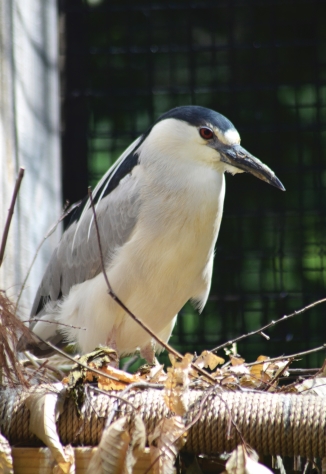Turkey Vulture
Cathartes aura
| Kingdom | Animalia |
|---|---|
| Phylum | Chordata |
| Class | Aves |
| Order | Cicniiformes |
| Family | Cathartidae |
| Genus | Cathartes |
| Species | C. aura |
| Lifespan | probably 4-5 years in the wild (banding record 16 years 10 months) |
| Size | 67-72 inch wingspan; weight 3.5-5 pounds |
| Eggs Laid | usually 2 eggs |
| Status | Common |

About Turkey Vultures
What are tips for identifying a Turkey Vulture?
Turkey Vultures are large blackish-brown birds having a characteristic featherless head with red skin. Mostly seen in flight, they are readily identified by their shape – wings held in a flattened “V” shape while it tilts slightly side to side. When seen from below, the flight feathers are silvery gray while the wing linings near the body are dark. Both male and female look alike but females are slightly larger.
What is the habitat of the Turkey Vulture?
Commonly found in farmland bordering forest, turkey vultures range throughout the United States and south into Central and South America. Roosting areas in large trees are an important habitat component. In northern parts of its range, Turkey Vultures are migratory and move to the southern United States and countries to the south.
How do they hunt and what do they eat?
Turkey Vultures are well adapted as scavengers and feed mainly on carrion although some insects and plant material are eaten as well. Weak talons and beaks make hunting strong, live prey nearly impossible. Soaring singly or in small groups, Turkey Vultures depend upon their excellent senses of smell and eyesight to find dead animals. Soaring speed is 15 - 20 mph and they stay low – at treetop level or about 200 feet above the ground to better detect food. Their “bald” heads help them to stay clean when feeding inside a carcass. Turkey Vultures play an important role by being part of nature’s clean-up crew. We can sometimes observe them helping humans by disposing of road kills.
How do Turkey Vultures raise their young?
No nesting materials support the eggs which are laid on the ground in such places as rocky crevices or hollow logs. Both adults share in incubating the eggs and raising the young, feeding them by regurgitation. Young Turkey Vultures fly at 70 to 80 days old.
Fun Facts!
- Turkey Vultures have recently been found to be close relatives of storks rather than of raptors like hawks, owls and eagles.
- Turkey Vultures can soar at 4,000 to 5,000 feet while migrating.
- Watch out if a Turkey Vulture is threatened – it regurgitates its stomach contents!
- How do Turkey Vultures stay cool? They defecate on their legs and the subsequent evaporation cools the birds while strong acids kill bacteria.
- Their name comes from the fact that their featherless red heads resemble those of turkeys.


























